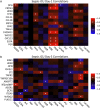Novel plasma protein biomarkers from critically ill sepsis patients
- PMID: 36572854
- PMCID: PMC9792322
- DOI: 10.1186/s12014-022-09389-3
Novel plasma protein biomarkers from critically ill sepsis patients
Abstract
Background: Despite the high morbidity and mortality associated with sepsis, the relationship between the plasma proteome and clinical outcome is poorly understood. In this study, we used targeted plasma proteomics to identify novel biomarkers of sepsis in critically ill patients.
Methods: Blood was obtained from 15 critically ill patients with suspected/confirmed sepsis (Sepsis-3.0 criteria) on intensive care unit (ICU) Day-1 and Day-3, as well as age- and sex-matched 15 healthy control subjects. A total of 1161 plasma proteins were measured with proximal extension assays. Promising sepsis biomarkers were narrowed with machine learning and then correlated with relevant clinical and laboratory variables.
Results: The median age for critically ill sepsis patients was 56 (IQR 51-61) years. The median MODS and SOFA values were 7 (IQR 5.0-8.0) and 7 (IQR 5.0-9.0) on ICU Day-1, and 4 (IQR 3.5-7.0) and 6 (IQR 3.5-7.0) on ICU Day-3, respectively. Targeted proteomics, together with feature selection, identified the leading proteins that distinguished sepsis patients from healthy control subjects with ≥ 90% classification accuracy; 25 proteins on ICU Day-1 and 26 proteins on ICU Day-3 (6 proteins overlapped both ICU days; PRTN3, UPAR, GDF8, NTRK3, WFDC2 and CXCL13). Only 7 of the leading proteins changed significantly between ICU Day-1 and Day-3 (IL10, CCL23, TGFα1, ST2, VSIG4, CNTN5, and ITGAV; P < 0.01). Significant correlations were observed between a variety of patient clinical/laboratory variables and the expression of 15 proteins on ICU Day-1 and 14 proteins on ICU Day-3 (P < 0.05).
Conclusions: Targeted proteomics with feature selection identified proteins altered in critically ill sepsis patients relative to healthy control subjects. Correlations between protein expression and clinical/laboratory variables were identified, each providing pathophysiological insight. Our exploratory data provide a rationale for further hypothesis-driven sepsis research.
Keywords: Biomarkers; Critical care; ICU; Proteomics; Sepsis.
© 2022. The Author(s).
Conflict of interest statement
The authors declare that they have no competing interests.
Figures



Similar articles
-
Novel Outcome Biomarkers Identified With Targeted Proteomic Analyses of Plasma From Critically Ill Coronavirus Disease 2019 Patients.Crit Care Explor. 2020 Aug 24;2(9):e0189. doi: 10.1097/CCE.0000000000000189. eCollection 2020 Sep. Crit Care Explor. 2020. PMID: 32904064 Free PMC article.
-
Putative biomarkers of hepatic dysfunction in critically ill sepsis patients.Clin Exp Med. 2025 Jan 3;25(1):28. doi: 10.1007/s10238-024-01545-3. Clin Exp Med. 2025. PMID: 39751971 Free PMC article.
-
Circulating soluble urokinase plasminogen activator receptor is stably elevated during the first week of treatment in the intensive care unit and predicts mortality in critically ill patients.Crit Care. 2011;15(1):R63. doi: 10.1186/cc10037. Epub 2011 Feb 16. Crit Care. 2011. PMID: 21324198 Free PMC article.
-
Effect of erythromycin on mortality and the host response in critically ill patients with sepsis: a target trial emulation.Crit Care. 2022 May 24;26(1):151. doi: 10.1186/s13054-022-04016-x. Crit Care. 2022. PMID: 35610649 Free PMC article.
-
Chlorhexidine bathing of the critically ill for the prevention of hospital-acquired infection.Cochrane Database Syst Rev. 2019 Aug 30;8(8):CD012248. doi: 10.1002/14651858.CD012248.pub2. Cochrane Database Syst Rev. 2019. PMID: 31476022 Free PMC article.
Cited by
-
Hyperferritinemia Screening to Aid Identification and Differentiation of Patients with Hyperinflammatory Disorders.J Clin Immunol. 2024 Sep 12;45(1):4. doi: 10.1007/s10875-024-01797-4. J Clin Immunol. 2024. PMID: 39264477 Free PMC article.
-
Mortality-associated plasma proteome dynamics in a prospective multicentre sepsis cohort.EBioMedicine. 2025 Jan;111:105508. doi: 10.1016/j.ebiom.2024.105508. Epub 2024 Dec 15. EBioMedicine. 2025. PMID: 39681038 Free PMC article.
-
Hyperferritinemia screening to aid identification and differentiation of patients with hyperinflammatory disorders.Res Sq [Preprint]. 2024 Jun 25:rs.3.rs-4523502. doi: 10.21203/rs.3.rs-4523502/v1. Res Sq. 2024. Update in: J Clin Immunol. 2024 Sep 12;45(1):4. doi: 10.1007/s10875-024-01797-4. PMID: 38978562 Free PMC article. Updated. Preprint.
-
Differential expression of plasma cytokines in sepsis patients and their clinical implications.World J Clin Cases. 2024 Sep 6;12(25):5681-5696. doi: 10.12998/wjcc.v12.i25.5681. World J Clin Cases. 2024. PMID: 39247745 Free PMC article.
-
Therapeutic Targets for Sepsis: Multicenter Proteome-Wide Analyses and Experimental Validation.J Proteome Res. 2025 Jul 4;24(7):3498-3506. doi: 10.1021/acs.jproteome.5c00148. Epub 2025 Jun 3. J Proteome Res. 2025. PMID: 40459852 Free PMC article.
References
LinkOut - more resources
Full Text Sources
Research Materials
Miscellaneous
